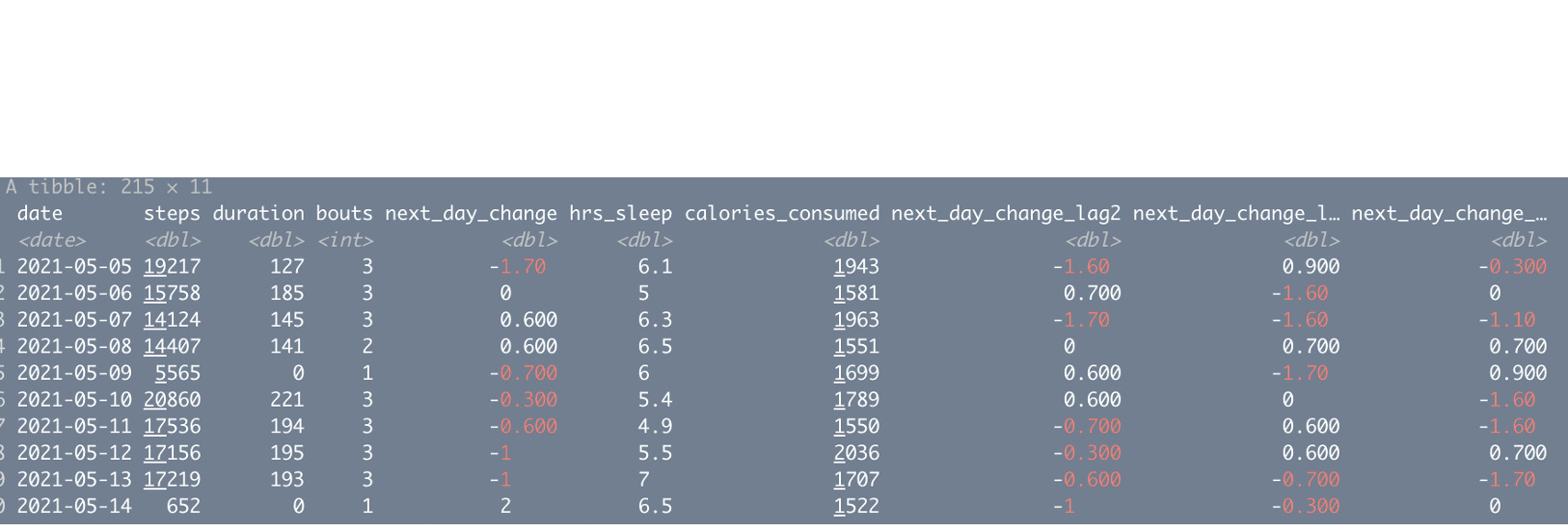Diet tracking, re-imagined!
Tracking your diet is nice, but it only tells you part of the story!
I believe that to truly get the most out of dietary tracking, it should be combined with additional metrics that are individualized to a person’s goals and challenges. Together, this can offer unique and powerful insights that would otherwise be missed when measuring diet alone.
There are many reasons to track your diet if you’re trying to reach any type of health, weight loss, or performance goal. From the obvious – knowing how many calories you’re consuming, to simply being more aware of what you’re eating, and/or avoiding excess snacking because it’s a pain to log.
But there are many other questions that come up, which can be solved by a little bit of additional tracking…
- How do you know if you’re eating enough to support your training?
- What is causing the afternoon energy crash?
- How to reduce sugar cravings?
- How to adjust calories based on exercise or daily steps?
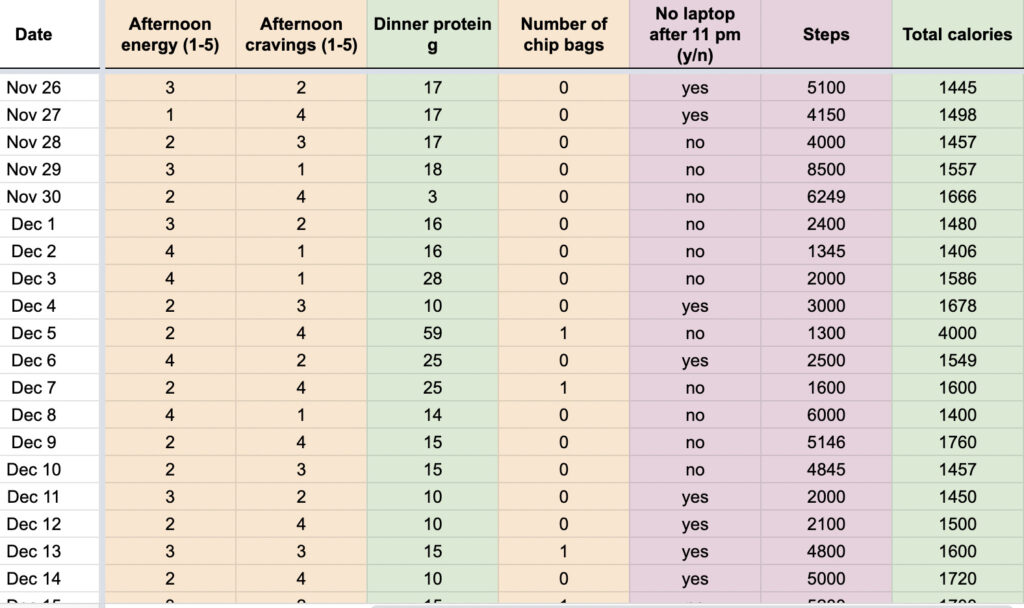
With a spreadsheet and some data analysis, we can glean valuable insights that would not be captured simply from looking at macros on MyFitnessPal. And by using some more advanced analysis, we can do things like figure out which factors have the biggest influence on someone’s weight loss (or other goals), and use model predictions to understand what happens when you’re changing more than one thing (like calorie intake and exercise)!
Here are some examples of how I’ve been using tracking with people I work with…
Avoid under-eating on hard training days
Client: Competitive age-group cyclist training 10-12 h per week
Goal: Lose ~4 kg while sustaining or increasing power
Challenge: He needs to be in a calorie deficit to lose fat, but too big of a deficit puts him at risk for muscle loss, poor recovery, and decreased performance.
Additional tracking: Exercise duration, exercise intensity, and calories burned during exercise (based on his power meter, which means it’s fairly accurate).
Tracking calories burned during exercise allowed me to calculate his daily Energy Availability, which is a measure of how many calories the body has available, after subtracting what’s been burned during exercise. For example, if you consume 2500 kcal and burn 500 kcal during exercise, there are 2000 kcal remaining. We then calculate energy availability as calories per kg of fat-free mass. For example, if someone weighs 70 kg and has 20% body fat, we’d multiply 70*.8 to get 56 kg of fat-free mass, and then divide the available calories (2000) by 56 to get 35.7 kcal per kg fat-free mass.
Although there is no exact cutoff, values of 30-45 are generally recommended for optimal health and performance. In this case I felt like 20 was an appropriate lower limit based on our conversations, my observations of his diet, and the fact that I didn’t have a gold-standard measure of body fat percentage (which influences the calculations).
As we see on the left, he does a great job of increasing his calorie intake to match his expenditure, eating more when he burns more. Each dot represents a different day, with the dotted line indicating the trend and the r value showing how strong of a correlation there is between the amount of calories burned during exercise, along the bottom, and the daily calorie intake.

However, he’s only making up for a portion of his expenditure which means as he burns more calories, he’s also creating a larger energy deficit! On the right we see that on days with bigger workouts he’s dipping into very low energy availability and potentially sacrificing his ability to recover. The dotted line denotes a value of 20 kcal/kg/FFM, the lowest level I’d be comfortable with him getting to. The good news is we were able to make the appropriate adjustments, and he was able to achieve his goal weight and peak for a big week of racing.
Find unexpected connections
Client: 30 yo female
Goal: Lose weight, reduce cravings, and increase energy levels
Challenge: Trying to lose weight while also training for an Ironman, she struggled with sugar cravings and low afternoon energy levels.
Additional tracking: Protein content of each meal, afternoon energy level and afternoon cravings (on a scale of 1-5), whether she was outside in the sunshine for at least 15 minutes at some point during the morning (yes or no).
When I hear about sugar cravings and an afternoon energy crash, protein intake is usually the first thing I think about. In this case her protein intake at breakfast and lunch was generally quite low, so we talked about ways to increase it. We also talked about the importance of sunshine, particularly in the morning. Sunlight is critical for setting a strong internal body clock, can enhance cognitive performance, and can even shrink fat cells! So, in addition to tracking her protein intake and rating her daily levels of afternoon energy and cravings, she also noted if she’d been out in the sun for at least 15 minutes that morning.
I was expecting some effect, but nothing this extreme!
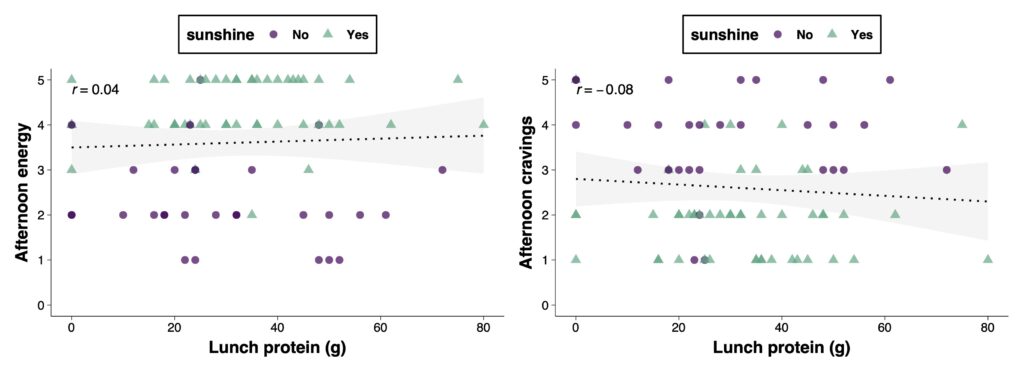
As we see, there was no relationship between the amount of protein she had at lunch (or breakfast) and her afternoon energy levels or sugar cravings (evidenced by the dotted trend line being horizontal and the low r-value). But — by comparing the green triangles to the purple dots, we see that when she was out in the sunshine, even for just a little bit, her afternoon energy levels were nearly always 4–5 out of 5, while her cravings were nearly always 1–2 out of 5. In contrast, if she didn’t get out in the sun, she was tired and craved sugar in the afternoon!
This information is so valuable and would not have been seen simply by tracking her diet. This doesn’t mean tracking isn’t important, but it helps set her up for greater success by learning how to reduce cravings and improve energy levels!
Do the weekend cheat meals matter?
This is from a guy who has been very successful with his weight loss, losing about 50 lbs over 6 months. Each dot represents daily weight change, with the purple dots indicating weight gain from one day to the next, and the green dots indicating weight loss. What this shows, is that on average he gained weight on Fridays and Saturdays and lost weight the rest of the week. In this case it didn’t affect his overall weight loss trajectory, but it is good to see the trend and be able to know where to look if progress stalls.
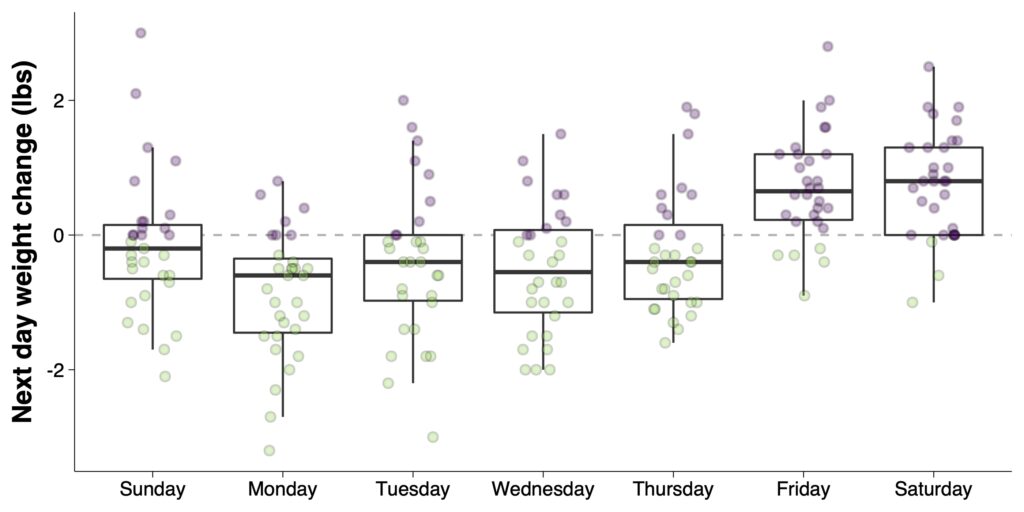
But that is not all, it gets even better…
What matters most for weight loss?
We can also use statistical modelling to figure out what factors are having the biggest influence on our desired outcome (in this case, weight loss).
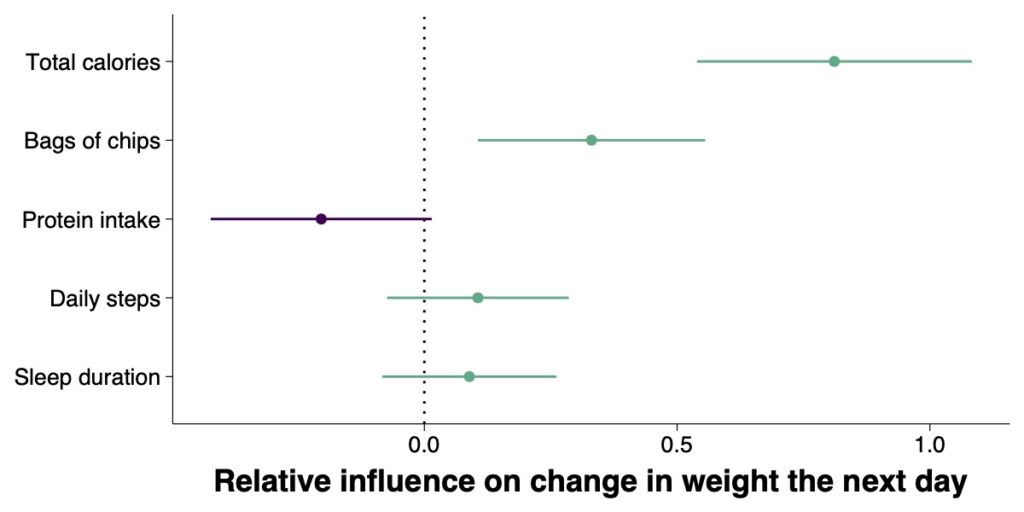
This woman was tracking her diet, as well as how many bags of chips she ate (snack size), how many steps she took, and her sleep duration.
This shows the relative influence for each of these factors on daily weight change. Dots to the right of the dotted line indicate it causes an increase in weight, and to the left indicate a decrease. The lines represent the confidence intervals (range of likely estimated values). What this figure tells us is that total calories have the largest impact (not surprising), and that the amount of chips and her protein intake are also important, while daily steps and sleep duration are, in this case, not having as big of an influence on her weight.
If I exercise more, can I eat more?
Finally, this example is from a guy who does a lot of walking as a key aspect of his weight loss strategy.
After collecting enough days of tracking, we can use a person’s data in a statistical model to understand the interaction between factors like daily steps and calorie intake. This is important because the more you walk (or exercise), the hungrier you’ll get!
The three lines represent three different daily calorie intakes, and we can predict the expected change in weight based on the number of steps he takes. So, if he consumes 1700 kcal and takes 10,000 steps, we’d expect a weight loss of about 0.25 lbs, whereas if he consumed 2000 kcal and took 13,000 steps, we’d expect no change.
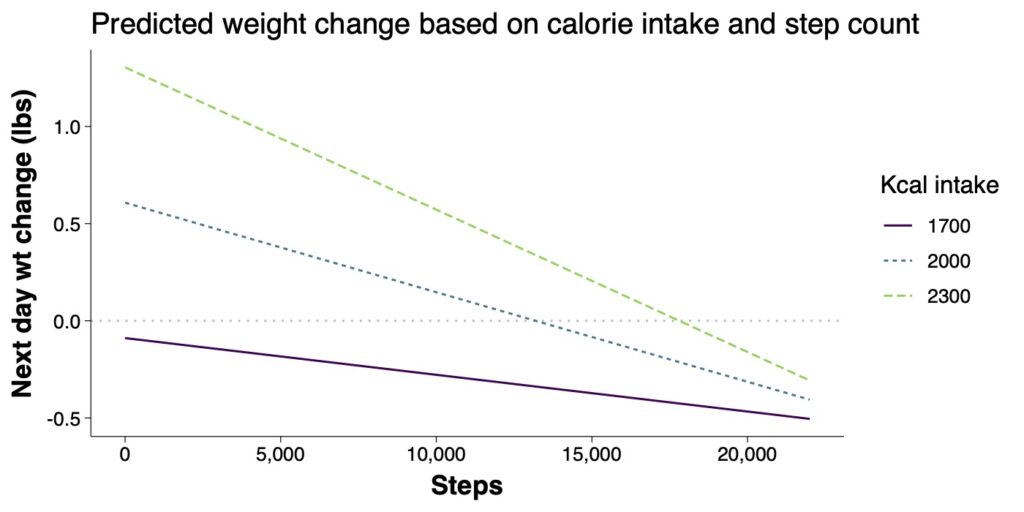
This is just the tip of the iceberg in terms of how we can use data like this. If you’re curious to know if something like this could work for you, schedule a free 15-minute call!
Finally, I should note that after working with several hundred clients it’s very clear to me that some people enjoy tracking their diet, while many others find it incredibly tedious, a pain, and not worth doing. Because of this, I never insist someone tracks their food intake. However, for certain situations, it does seem to be one of the most effective ways to improve progress.
If you know someone who diligently tracks their calories but is not seeing the progress they’d expect or hoped for, please forward this post to them!
